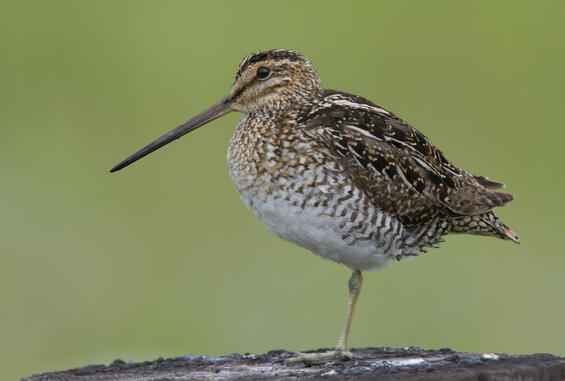- Scientific name: Gallinago delicata
Species of Greatest Conservation Need (MA State Wildlife Action Plan)
Description

Wilson's snipe
The Wilson’s snipe is a cryptically colored, medium-sized (27-32 cm [10.6-12.6 in]) sandpiper with a very long, straight bill. Wilson’s snipe inhabit wet meadow habitat during both migration and the breeding season, and are perhaps best known for their dramatic courtship/territorial display: a high, circular, often crepuscular flight accompanied by the tremulous winnowing sound of air passing through the flying birds outstretched tail feathers, modulated by rhythmic wing beats.
Life cycle and behavior
Peak spring migration for Wilson’s snipe occurs in mid-April, and most breeding birds are on their territories in Massachusetts by early May. Males perform elaborate crepuscular flight displays - often referred to as winnowing-over their habitat of large, low graminoid marshes to establish territory and attract a mate. Female Wilson’s snipe will join the male in winnowing as part of the pair’s courtship. The female will then select a nest site, often a slight depression at the edge of breeding habitat, where she will lay 2-4 eggs. Eggs are incubated for 18-20 days, and at hatching, chicks are mobile and can feed themselves. Most Wilson’s snipe begin migration in late September, but a small number of birds regularly overwinter in Massachusetts, especially near the coast.
Population status
Wilson’s snipe are locally common migrants across Massachusetts, but as breeders are highly restricted in the state, relegated primarily to Berkshire County and a few sites east into central Massachusetts.
Distribution and abundance
Massachusetts is at the southern edge of the Wilson’s snipe’s breeding range, which covers most of sub-Arctic Canada and the northern United States. Wilson’s snipe overwinter across temperate United States, south into Central America.
Atlas 1 (1974-1979) surveys found that Wilson’s snipe were most often found in the high hills of the Berkshire and
Taconic region, where the high-elevation bogs most closely resembled their more typical boreal wetland breeding areas. Six out of seventeen records occurred in the Berkshire Highlands region, with a few more in the Taconic Mountains and Marble Valleys. Farther east in the state, evidence of breeding Wilson’s snipes was thin. A probable record in the Connecticut River Valley and a pair of occupied blocks in the Lower Worcester Plateau were the only signs of the snipe’s presence in central Massachusetts. No breeding was confirmed anywhere in eastern Massachusetts, but a handful of occupied blocks suggested that breeding may have been still occurring in small numbers in secluded marshes.
The Wilson’s snipe continued to be a rare and local summer resident and breeding bird in Atlas 2 (2007-2011) and was only found at a few scattered locations. The greatest concentration of snipes was in the Berkshire Highlands region.
Habitat
Wilson's snipe breeds in large wet sedge meadows and freshwater marshes with low emergent vegetation. During migration and winter, snipes can also be found in salt marshes, estuaries, and agricultural fields.
Healthy habitats are vital for supporting native wildlife and plants. Explore habitats and learn about conservation and restoration in Massachusetts.
Threats
Loss of suitable wetland habitat to is the primary threat to Wilson’s snipe in Massachusetts. Historically, this wetland loss was due to ditching, filling, and draining. Modern loss of suitable wetland habitat for Wilson’s snipe is now primarily due to successional advance in wetlands (for example, wet meadows becoming shrubby) and invasive species. Climate change is a threat to this species by altering hydrologic regimes that sustain wetland habitats.
Predation by domestic cats has been identified as the largest source of mortality for wild birds in the United States with the number of estimated mortalities exceeding 2 billion annually. Cats are especially a threat to those species that nest on or near the ground.
An additional threat to the species is collisions with buildings and other structures, as approximately 1 billion birds in the United States are estimated to die annually from building collisions. A high percentage of these collisions occur during the migratory periods when birds fly long distances between their wintering and breeding grounds. Light pollution exacerbates this threat for nocturnal migrants as it can disrupt their navigational capabilities and lure them into urban areas, increasing the risk of collisions or exhaustion from circling lit structures or areas.
Conservation
Maintaining suitable wetlands in an open of low, graminoid-dominated state through prescribed fire, periodic mowing, and/or grazing is an essential conservation action, along with the control of invasive species.
Promote responsible pet ownership that supports wildlife and pet health by keeping cats indoors and encouraging others to follow guidelines found at fishwildlife.org.
Bird collision mortalities can be minimized by making glass more visible to birds. This includes using bird-safe glass in new construction and retrofitting existing glass (e.g., screens, window decals) to make it bird-friendly and reducing artificial lighting around buildings (e.g., Lights Out Programs, utilizing down shielding lights) that attract birds during their nocturnal migration.
References
Breeding Bird Atlas Explorer (online resource). 2015. U.S. Geological Survey Patuxent Wildlife Research Center. <2015-04-01>. http://www.pwrc.usgs.gov/bba. Data compiled from: Massachusetts Breeding Bird Atlas 2007-2011
Mueller, H. 1999. Wilson's snipe (Gallinago delicata), The Birds of North America Online (A. Poole, Ed.). Ithaca: Cornell Lab of Ornithology; Retrieved from the Birds of North America Online: http://bna.birds.cornell.edu/bna/species/417
Sauer, J.R., J.E. Hines, J.E. Fallon, K.L. Pardieck, D.J. Ziolkowski, Jr., and W.A. Link. 2014. The North American Breeding Bird Survey, Results and Analysis 1966 - 2013. Version 01.30.2015 USGS Patuxent Wildlife Research Center, Laurel, MD
Veit, R.R., and W.R. Petersen. 1993. Birds of Massachusetts. Massachusetts Audubon Society, Lincoln MA.
Contact
| Date published: | April 4, 2025 |
|---|